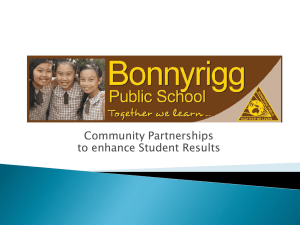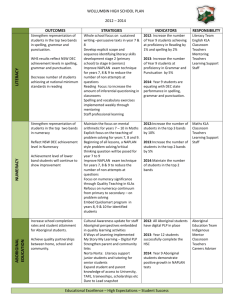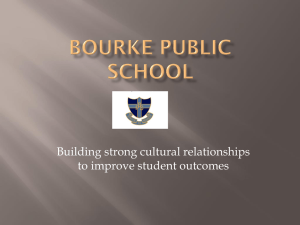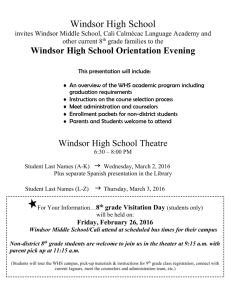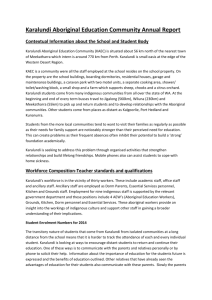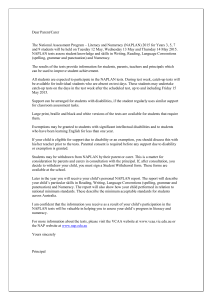Annual School Report 2009
advertisement
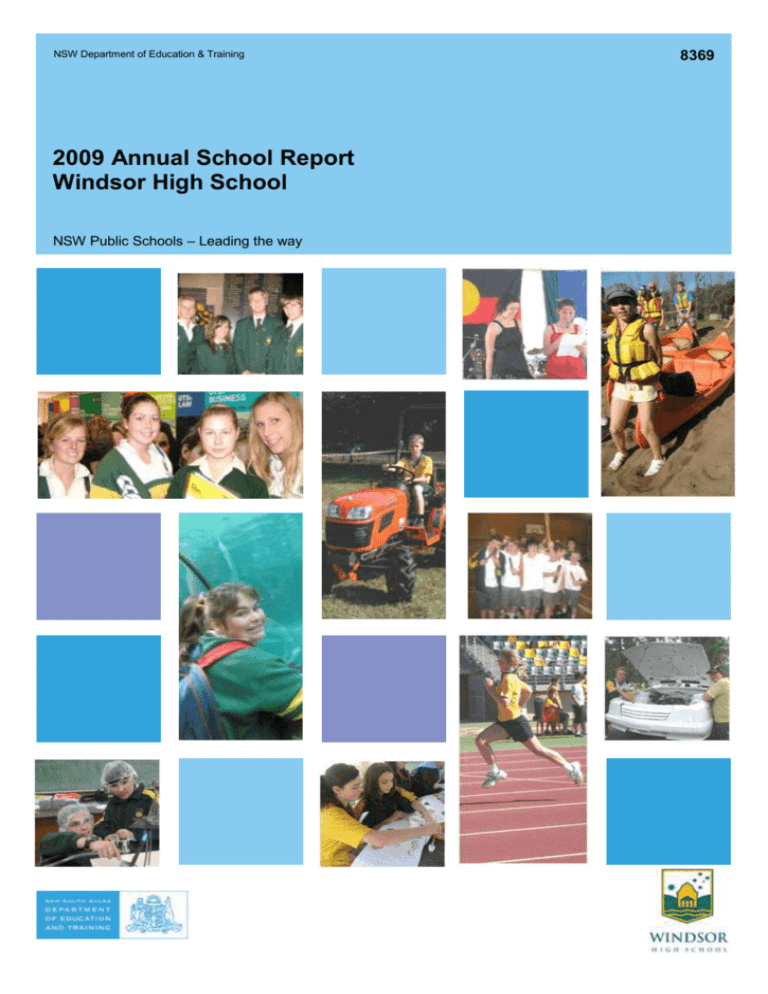
NSW Department of Education & Training 2009 Annual School Report Windsor High School NSW Public Schools – Leading the way 8369 Messages We issued laptops to all Year 9 student as part of the Digital Education Revolution. Principal's message Successful musical evenings by CAPA. Purchase of interactive whiteboards. A whole school review of student welfare and a review of the Support Unit. Strengthening of our already strong links with the partner Primary schools to establish an improved learning community. Windsor High School (WHS) is a proud public school and has a proud tradition of serving its community. At WHS there is strong partnership between the school and its staff, the parents and the community and the students. These achievements are for the benefit of all those in the community – in the Windsor community, in the broader Australian community and ultimately, in the global community. Our focus remains well and truly on meeting the learning needs of each and every student across the whole school. I certify that the information in this report is the result of a rigorous school self-evaluation process and is a balanced and genuine account of the school's achievements and areas for development. The focus for the school this year has been upon lifting expectations of the staff, students and community for the school. We have introduced the Positive Behaviour for Learning (PBL) initiative to assist us. Mrs Annette Cam P&C and/or School Council message The Parents & Citizens Association Incorporated provides an important opportunity for parents and carers to enjoy a positive partnership with WHS executive and staff in the education of our children. This forum promotes open and inclusive discussion in all aspects of school life and also allows the school community to remain informed on priorities, strategies, targets and allocation of resources within the school. The involvement of the parent body in the process of setting goals and future directions ensures the needs of the school community are reflected and decisions made are in the best interest of students. Some highlights of the year are listed below: Approval of the Trade Training Centre plans which will provide us with an industrystandard kitchen and metalwork room. A Federal Government grant of $96,000 to establish an Enterprise Skills Centre for Business Services and Primary Industries. Building Education Revolution money used to improve the classroom environment, the playground and provide new sheds. Funding of a homework centre afternoons a week for senior students. two Outstanding Aboriginal Education programs. An active SRC and student leaders, who represented the school in the Hawkesbury Youth summit. Continued success with our show-goats and the student show-team. Formation of the new Macquarie sports zone. Airconditioning in many classrooms The launch of a statewide antibullying program targeting cyberbullying in association with the Hon. John Aquilina,. Our school encourages and values active involvement of parents and carers and invites our participation in a number of ways: active and supportive P&C Association representation on committees and selection panels for school staff and student leaders guest presenters at Graduation Presentation Assemblies development, review and evaluation of school programs and policies parental support of a wide range of cultural and sporting events and During the year P&C handed over management of the uniform shop to the school due to our inability to consistently man the operation adequately with volunteers. The uniform shop remains a convenient and economic option for the purchase of uniforms and should continue to be supported. Any profit provides a source of funds to assist school initiatives and purchase resources for our students. It is encouraging to see students wearing their school uniform with pride and promoting a positive image for themselves and Windsor High. 2 In 2009 the P&C honoured past president, Julie Gough with Life Membership of WHS P&C in recognition of her distinguished service to the school and its community. Julie was awarded in appreciation of a long and dedicated association with P&C in both the primary and high school arenas for 20 years. She was devoted to achieving the best outcomes for the students and school community at large. Julie has the gratitude of parents, students and staff for her commitment over so many years. The week after Pink Ribbon Day was Bandanna Day. The SRC in conjunction with the canteen proprietors at Windsor High alternate who organises Bandanna Day each year. Either way both the SRC and the canteen are both involved in the promotion and selling of Bandanna Day, selling Bandannas and pens to raise money for Canteen, the Australian Organisation for Young People Living with Cancer. As well as fundraising, the SRC was involved in programs and meetings that were aimed to make students more involved and aware of changes going on throughout the school and the community. A good example of this was the Jan Trevarthen Student representative's message Last year the Student’s Representative Council (SRC) conducted several fundraisers, both for the school and charities. The first was Valentine’s Day - over $500 was raised from the sale of roses, all profits going to the school. In March we celebrated Harmony Day. For several years the SRC has been involved in Harmony Day and the associated activities that are organised. The food stalls are always a big success and the money raised goes to the school. Several cake stalls were held at various times throughout last year and are always popular with both staff and students. Usually a cake stall would be held if there was a large gap between organised fundraisers. success surrounding the Hawkesbury Youth Summit. This was a day focusing on the youth and young leaders from around the community and the role that they play. The SRC attended this conference and spoke to local Government about issues concerning them. The first charity fundraiser for the year is generally Australia’s Biggest Morning Tea. After registering online, a large morning tea was held to raise money for the Cancer Council. However the most popular fundraiser among the students is always Jeans for Genes Day. By allowing students to wear jeans to school and bring a gold coin donation, the SRC was able to send all the money raised to the Children’s Medical Research Institute. Using the new technology in the Smart Room, Windsor High’s SRC was able to have a meeting with the SRC from Richmond High School, allowing us to exchange ideas for fundraising and other programs and activities that could benefit both schools. The money that was raised throughout the year was spent on a fantastic school program, Duke of Edinburg. The SRC donated $700 to this program so they could purchase much needed safety equipment. Soon after Jeans for Genes Day was Legacy Week. During this week, usually on the Friday, the SRC sends representatives into Windsor Town Centre to sell badges to the public. The students are more than happy to help this foundation and are always enthusiastic and polite, even when it is pouring rain. Lucille Shilling School context For the first time last year, Windsor High registered as a fundraiser for Pink Ribbon Day. This involved selling merchandise sent to the school, to which all the proceeds went to the Council. As well as selling out on merchandise, the SRC organised a morning tea, selling cakes and slices. This combined with the proceeds from the products sold meant that Windsor High was able to send over $300 to the Cancer Council. The success was so great that it was decided to continue this fundraiser every year. Student information It is a requirement that the reporting of information for all students must be consistent with privacy and personal information policies. Student enrolment profile Enrolments have been dropping over the past five years. Programs will be developed over the next few years in an attempt to reverse this trend. 3 Student attendance profile Post-school destinations Analysis of the data shows that attendance is weak particularly in Year 11. In 2010, strategies will focus on improving attendance in all years. A destination survey of the 2009 HSC cohort was conducted in mid-March 2010. Of the 50 students who completed the HSC in 2009, we were able to contact 36 students (72%). Eleven of the students contacted (22%) were offered a place at University and one of these students deferred their university offer. Of the remaining 10 students, 8 are at University of Western Sydney, 1 at Macquarie University and 1 at the University of Newcastle. Most of these students have part time work. As well as the eleven mentioned above, one student is completing a Diploma in Hospitality at a private college. Management of non-attendance Eleven students (22%) gained apprenticeships. The apprenticeships include Automotive, Warehousing, Boilermaking, Carpentry, Electrical, Beauty Therapy, Hairdressing and Childcare. Student attendance at school is one of the keys to improving student learning outcomes and to ensuring student wellbeing. Monitoring student attendance is a whole-school responsibility. Staff record student attendance each lesson on a centralised school database. Non-attendance is reported to parents by letter and by phone calls home. Parents must explain each absence via a written note or a phone call to the school. Medical certificates are to be provided where possible for illness. Ten students have entered full-time employment. Half the students are employed in Retail, the rest in Hospitality, Aged Care and Building. Three students were looking for work when contacted and not currently engaged in further education. One student is repeating the HSC. Absences are monitored by the Senior School and Middle School teams and discussed with the students. Continued absence is discussed with the Deputy Principal, the parent and the child. If poor attendance continues, then the Principal will discuss the issue with the parents and the student. Individual plans are developed to assist improve attendance, including daily lesson-bylesson monitoring of attendance by staff. Sixty percent of the students contacted said that they had planned their present pathway while they were at school. The small number of students in the 2009 cohort makes generalisations difficult but the following can be said For students under school leaving age a referral is made to the Home School Liaison Officer. there is a relatively small unemployment rate amongst the students (below state average) just under half the cohort has opted to stay in education and training; and it is obvious that our students have planned their post school options and the majority have succeeded in carrying out their plans. Retention to Year 12 The proportion staying on to HSC from SC has increased over the past three years and is now level with the School Education Group (SEG). 4 Year 12 students undertaking vocational or trade training Staff establishment In 2009, 62% of all senior students were enrolled in Vocational Education and Training (VET) courses (70% of Year 11 students and 50% of Year 12 students). Four courses ran at our school: Business Services, Entertainment, Hospitality and Primary Industries. Students from cluster schools attended the Business Services course at Windsor High School and our students attended Richmond High School for Construction. Our students also attended TAFE studying courses like Animal Care, Hairdressing, Beauty Therapy, Automotive and Nursing. In 2009, 15 students were completing school based traineeships in Warehousing, Automotive, Hospitality, Retail and Entertainment. Position Number Principal Deputy Principal(s) Head Teachers Classroom Teachers Teacher of Emotional Disabilities Teacher of Mild Intellectual Disabilities Support Teacher Learning Assistance Teacher Librarian Counsellor School Administrative & Support Staff (SASS) Total 1 1 8 31.4 1 2 0.9 1 1 Windsor High School temporary teacher’s aid. In 2009 building also commenced on our Primary Industries area and a dedicated Business Services room. The funding for these upgrades was a result of applications for federal government funding. These areas will now have industry standard facilities and will greatly enhance the learning of our students. has 59 indigenous Financial summary This summary covers funds for operating costs and does not involve expenditure areas such as permanent salaries, building and major maintenance. Date of financial summary: Year 12 students attaining HSC or equivalent vocational educational qualification Income Balance brought forward Global funds Tied funds School & community sources Interest Trust receipts Canteen Total income Fifty students gained their HSC in 2009 which is 91% of students who completed one or more HSC subject while three students were on pathways. Of the 50 students who completed their HSC one student gained a life skills HSC while 50% of students studied vocational education subjects. Staff information 30/11/2009 $ 861 649.55 369 235.87 316 646.65 126 836.05 35 460.27 67 639.98 0.00 1 777 468.37 Expenditure It is a requirement that the reporting of information for all staff must be consistent with privacy and personal information policies. Teaching & learning Key learning areas Excursions The staff at Windsor High School is dedicated to the school and work very hard to provide a suitable learning environment. Some staff members have been teaching at Windsor High for 30 years, and also some are new to the teaching. This blend of experience provides diversity in thought and practice for the students. Extracurricular dissections Library Training & development Tied funds Casual relief teachers Administration & office School-operated canteen Utilities Maintenance Trust accounts Capital programs Total expenditure Teacher qualifications All teaching staff meet the professional requirements for teaching in NSW public schools. Balance carried forward Qualifications Degree or Diploma Postgraduate one 11.7 % of staff 100% 11% 85 372.87 33 052.69 45 466.75 8 169.31 14 742.19 454 816.44 20 954.18 106 950.21 0.00 93 655.39 57 993.37 133 519.71 8 124.60 1 062 817.71 714 650.66 A full copy of the school's 2009 financial statement is tabled at the annual general meetings of the School Council and/or the parent 5 body. Further details concerning the statement can be obtained by contacting the school. achievements in 2009 were various and of a high standard. Swimming – Jaymie Eaton swam magnificently all season, her efforts culminating in representation at Combined High Schools (CHS) Swimming where she contested the 50 metre freestyle. School performance 2009 Achievements Arts The Creative and Performing Arts are strong both in the curriculum and as an extra-curricular opportunity. WHS students regularly participate and perform at school events, such as Year 6 Orientation Day, Semester Award Assemblies, Creative and Performing Arts Workshops, Education Day and Presentation Dinner. The school musical “Pirates, Parrots and Penguins” (written by our Drama teacher, Mark Clark) drew together those students talented in drama, dance and music. The cast of 70 performed five shows over five nights to an appreciative audience of over a thousand students, parents and community guests. This year’s Musical Concert provided another rich opportunity for our music students to demonstrate their skills and talents on the stage. Senior music students performed their Higher Schools Certificate repertoire and Senior Entertainment students organised and ran the show. Triathlon – At the NSW CHS Teams Triathlon Championships, WHS had three teams competing for the first time. Junior Boys included Owen Morgan, Rowan Ridge and Aaron Trevarthen; Intermediate Boys included Matthew Davis, Joshua Hardman and Anthony Connors. Intermediate Girls included Emily Morgan, Tayla Barnes and Madison Keir. Hawkesbury Cup Competitions – WHS was well represented in all facets of the final Hawkesbury Cup competitions in Basketball, Soccer, Rugby League and Netball. Miles Sneddon was selected as part of the Hawkesbury Zone Basketball competition. Indoor Soccer State Championships, was held at Penrith Sport Stadium. After qualifying through the Regional Championships the 14 year old Boys team competed against the best teams in the state, including public and independent schools. Sydney West Representation – Brett Jones and Louise Maclure for Cricket. Brett Jones received a NSW Blue for his outstanding contribution to cricket. Senior students James Reifenstein, Kaylah Hurst and Mitchell Flander formed the core of our stage band for the musical and achieved outstanding HSC performances. Dance Report Students can always be found in Music, Drama and Art rooms practising and working on their various projects. Under the leadership of our Creative and Performing Art teachers, students continue to excel in this area. The Windsor High School Dance Ensemble had a fabulous year in 2009. The group was successful in their auditions for both the Sydney West Dance Festival and the Hawkesbury Dance Festival. At both performances the Ensemble performed a contemporary routine called ‘Running Up That Hill’. The students received excellent feedback from festival organizers and audience members about their professionalism on and off the stage. Sport WHS values sport and encourages the growth of student participation in all events. WHS’s sporting 6 The group consisted of students from years 7 – 12 and it was excellent to see all the different age groups working together and demonstrating the school core value of teamwork. Academic In the National Assessment Program, the results across the Years 3, 5, 7 and 9 literacy and numeracy assessments are reported on a scale from Band 1 to Band 10. The achievement scale represents increasing levels of skills and understandings demonstrated in the assessments: Yr 7, from Band 4 (lowest) to Band 9 (highest for Year 7); Yr 9, from Band 5 (lowest) to Band 10 (highest for Year 9) In the School Certificate the performance of students is reported in performance bands ranging from Performance Band 1 (lowest) to Performance Band 6 (highest). Literacy – NAPLAN Year 7 In Year 7 2009, there have been improvements over previous years in both Writing and Reading; more students achieved Band 9. The Spelling, Grammar and Punctuation results are below that of the Like Schools Groups for 2009. There are no previous test comparisons for these two tests. 7 Numeracy – NAPLAN Year 7 The Year 7 results for Numeracy were below the school average from 2007 – 2009 and are continue to be a focus of targeted improvement programs in 2010. Literacy – NAPLAN Year 9 For Year 9, Reading is above the LSG for 2009 in the higher bands. For Writing, WHS Year 9 is below the LSG. Both Reading and Writing will be a focus of improvement for the school in 2010. For Spelling and Grammar and Punctuation, the school is similar to the LSG average for 2009. 8 Numeracy – NAPLAN Year 9 In Mathematics, Australian History, Civics and Citizenship and Australian Geography, Civics and Citizenship, there have been no real gains in student achievement in 2009. Numeracy is below the LSG average for 2009 across the Year 9 cohort. However, the growth for individual students and particular groups (especially the Aboriginal students) was well above state average in 2009. In Computing Skills, there has been an increase in the percentage of students who have achieved Highly Competent compared to previous years. School Certificate relative performance comparison to Year 5 (value-adding) An improvement in value-added results are apparent in English, Science and Computer Skills in 2009 when compared to the school average for 2005 – 2009. School Certificate For English – literacy, there has been an improvement in the numbers of students achieving at Band 5 and Band 4 level and a reduction of the number of students achieving Band 2. No students achieved Band 1 result in 2009. Higher School Certificate Similarly, the Science results show improvement in 2009, with an increase in students achieving in Band 4 and a reduction in the lower bands. Students achieved particularly well in Business Studies, Business Services, Legal Studies, Retail Services, Music, PDHPE, Textiles and Design, Primary Industries, Visual Arts, Hospitality and Drama. 9 achieving at or above these standards are reported below. Percentage of Year 7 students in our school achieving at or above the minimum standard in 2009 Year 7 students achieved results closest to minimum standards in Numeracy and Spelling. Minimum Standard Information Percentage of Year 7 students achieving at and above minimum standard Reading Writing Spelling Punctuation and grammar Numeracy 84.3 86.8 88.0 80.7 89.0 Percentage of Year 9 students in our school achieving at or above the minimum standard in 2009 Higher School Certificate relative performance comparison to School Certificate (valueadding) Numeracy shows considerable progress towards achieving the goal of each child meeting minimum standards. There have been improvements in Reading as well. These improvements have resulted from the targeted programs addressing Numeracy across the whole school and individual programs to support children in Years 7 and 8. Percentage of Year 9 students achieving at and above minimum standard Reading Writing Spelling Punctuation and grammar Numeracy Despite some individually outstanding results for students in their HSC in some courses, overall students did not improve to the extent predicted by their School Certificate results. In 2010, an action research project will be established to begin to address this issue. 88.1 77.1 84.3 79.5 97.5 Significant programs and initiatives Minimum standards The Commonwealth Government sets minimum standards for reading, writing, grammar and punctuation, spelling and numeracy for years 3, 5, 7 and 9. The performance of the students in our school in the National Assessment Program – Literacy and Numeracy is compared to these minimum standards. The percentages of our students 10 Jake Denton and Blake Herczeg, obtained Indigenous traineeships in Business Services in the banking industry. Senior Aboriginal students attended the Indigenous Careers Day held in May. Aboriginal education An Indigenous community information evening and BBQ was held in March to welcome parents and to inform them of the opportunities for Indigenous students at WHS. Personal Learning Plans (PLPs) for all Aboriginal students have been developed in consultation with the Aboriginal community. A Peer Mentor Day at YMCA Yarramundi was held to assist the transition of Year 7 Aboriginal students to high school. In July the inaugural Allowah Day organised by the AECG and Hawkesbury High Schools was held at Cattai National Park for all secondary Aboriginal students. The Indigenous Leadership Group held meetings during 2009 with the aim of helping Indigenous students feel that they can make a difference at Windsor High. Aboriginal students played integral parts in whole school activities including Clean Up Australia and Education Week activities. Multicultural education In March we celebrated Harmony Day. The idea behind Harmony Day is to reflect on the valuable contribution of peoples from across the globe to our own community. For several years the SRC has been involved in Harmony Day and the associated activities that are organised. Every year a food stall is held where staff and students are encouraged to bring in food from different countries. These stalls are always a big success and the money raised from the stalls went towards the school. Respect and responsibility Windsor High School began Positive Behaviour for Learning (PBL) in 2009. PBL will play a major role in the structure of the school systems and the positive impact will be felt by students and staff alike. The basis of PBL lies in our school’s core STAR values: Safety; Teamwork; Achievement and Respect. The PBL team was convened in Term 4 and a matrix was created with input from the whole school community to provide a guide for how PBL will be seen in the different areas of the school. Data was collected to determine the main areas of need across the school, and the first focus area will be the playground. Staff were given an introduction to the matrix on the Staff Development Day in Term 4 and the launch of PBL has been planned for early in Term 2, 2010. A transition day for Year 6 Aboriginal students from our partner primary schools was organised in November. Students, with Bundeluk as guide, visited Cataract Falls in the Blue Mountains. Aboriginal students from Year 7 to Year 10 attended. To educate all students about Aboriginal history and culture all Year 7 students complete the school developed course called Jannunggai Deerubbin, or ‘My Hawkesbury’. The course focuses on Aboriginal studies and local heritage. The course included an Indigenous Culture Day where students participated in workshops on bush tucker, art, dance and dreaming stories. Other programs The Badanami Allowah Dancers performed at the Caroola Council of Elders Seafood Lunch held at UWS Richmond in March and at the Hawkesbury Show with the NSW Parks and Wildlife in May. Aboriginal art workshops were held as part of the sport program. Students produced three murals that are displayed in the Conference Room. Agriculture and Primary Industries Agriculture continues to make improvements to its farm including the farming of the dairy goats. There is a new shed and horticultural area that has been developed to provide skills to students who wish to gain more experience in the nursery enterprise. The long term goal will be to propagate and grow indigenous plants from our local environment. Plant stock will then be used in regional national parks, catchment areas and for roadside beautification. This plan is part of the Enterprise Skill Centre which involves courses in Agriculture, Business Services and Retail and Primary Industries. Primary Industries continues to attract students from the Senior school and other cluster schools. Stage 6 Aboriginal Studies was introduced in 2009. These students and Year 8 Aboriginal students attended the annual three day camp at Wreck Bay. Students had the opportunity to learn about bush tucker, care for the environment and the rich history of Indigenous people in this area of the South Coast. Aboriginal Studies students used this experience to complete a case study of the area. Year 10 students, Elizabeth Pearson, 11 There was no improvement in the valueadded score for Year 12 students in 2009. However, many single HSC courses achieved results better than the school average for 2006 – 2009 and better than Like Schools Group. Target 2 To improve student learning outcomes in School Certificate Our achievements include: The Show Team continues to exhibit the dairy goats at various shows including Canberra Royal and Sydney Royal. Our students are extremely successful in their participation in competitions such as Junior Handler and Junior Judging. The dairy goats were also incorporated into the agricultural teaching program for years 7-10. Academic reviews were held for students who were at risk of non-completion of their School Certificate. Attendance was monitored and discussed with individual students and their parents. The relative value-added scores for Year 10 students since Year 5 improved greatly in English Literature, Computing and Science. Target 3 To further increase achievement and participation levels for Aboriginal students Support Unit Our achievements include: The Support Unit at WHS has undergone many changes during 2009. We welcomed a new teacher Mr Erickson who came to us from Kingswood High and we farewelled Mr Chadderton who has left us to be with family at Casino High. This year we have achieved a wonderful result with one of the students in our severe class graduating from Year 12 with a Life Skills Higher School Certificate and successfully transitioning into employment. Cooking is a focus in our unit with our students showcasing their talents in the soup kitchen that caters for staff, each week offering another tempting choice cooked and served by our very talented students. The gymnasium continues to grow and all fitness levels continue to improve with the development of our individual fitness programs for all students and staff in our unit. Personalised Learning Plans (PLPs) were developed for all Aboriginal students from each cohort. Targets for PLPs were developed with reference to the students NAPLAN results. Students attended after school Learning Hubs to assist completion of assessment tasks. The links with the AECG were continued and strengthened. Attendance for Aboriginal students improved significantly with 40% of students showing above 90% attendance. The growth of Aboriginal students in NAPLAN (literacy and numeracy) was above the growth for students across the state. Aboriginal students took on leadership roles across the school including Year 7 Mentoring, Peer Support. Aboriginal students are involved in the Kimperwali Program including a case study at Wreck Bay, Badanami Allowah dancing, Longneck Lagoon Art Show and Allowah Day. Progress on 2009 targets Target 1 To improve student learning outcomes in the Higher School Certificate Our achievements include: Academic reviews were held for all students in Years 11 and 12. Attendance was monitored and discussed with individual students each week. Key evaluations It is a requirement for all NSW public schools to conduct at least two annual evaluations – one related to educational and management practice and the other related to curriculum. In 2009 our 12 school carried out evaluations of whole-school Welfare and of the Support Unit. role of Year Adviser might assist in ensuring continuity of staff in a welfare role. Educational and management practice Whole school Welfare Review In Term 3, 2009, Windsor High School instigated a review of its welfare systems and structures. The review was performed over four days and the findings released to the school community in Term 4 for implementation over the following year. The school’s involvement in Positive Behaviour for Learning (PBL) will allow a structure for the development of systems across the school, the incorporation of programs and practices and the use of data to assist decision-making. Future directions Build upon proactive programs to address the needs of all students, develop a wider range of specific programs to support targeted groups and individuals and explicitly link these programs across the school 1. The extent to which the school’s student welfare and discipline policy, programs, systems and procedures are designed to support student engagement and learning. Examine the existing management systems for example, the Executive structure, the middle school and senior school structure, and the roles and responsibilities for all staff. 2. The effectiveness of student welfare and discipline practices, including the operation of policy and programs from whole school to classroom levels. Develop a communication strategy across the school to assist in gaining support from teachers, students and parents (PBL Action Plan will assist) To collect information the panel interviewed with staff, students and parents. The Review panel observed lessons, assemblies, staff meetings and other routine activities and studied various documents including school plans, whole school policies and programs, minutes of meetings, school newsletters and student work samples. ‘Common vision, common experience’ Consistently implement the behaviour and learning strategies developed through the PBL Action Plan, specifically in relation to expectations and the consequences (positive or negative) for behaviour. Findings and conclusions Strengthen the link between learning and behaviour with reference to the Quality Teaching framework. Background The two terms of reference were: The main findings are summarised below: There are generally strong positive connections between staff, students and parents. Curriculum There are Student Welfare programs developed to address the needs of all students, targeted groups and individuals. Background Achievements across the school community are regularly acknowledged and celebrated. Response to student welfare issues is currently reactive rather than proactive and relies on the individual judgments of teachers. There are some systems to support student welfare in place, but they need to be explicitly linked and communicated clearly to all. The purpose of the Seminar sessions is not clear and the original purpose, which was to link students more closely with teachers, has been lost. common language, Support Unit Review This year the Support Unit benefited from a review to recognise our achievements and to help plan for the continued improvement of our unit. The review team was comprised of WHS staff, Regional Staff and a parent. Staff, students and parents were interviewed about how well the programs, procedures, systems and structures in the Support Unit supported the welfare and learning of students in the unit. Findings and conclusions A summary of the findings follows: The middle school and senior school structure has the potential to support all students, but roles and responsibilities need to be clearly articulated. Re-introducing the 13 A positive culture exists in each classroom with a strong focus on positive reinforcement and rewards Parents were very happy with the experiences of their children in the support unit Routines for the day/lessons were clearly displayed in each classroom, increasing student success Classrooms were set up to support the needs of individual students Students all had individual learning and behaviour plans that catered to all their individual needs Computers and ICT were used across all classrooms to enhance the learning of all students Analysis of the pre-test and post test results found that student’s numeracy skills had improved by 23%. Comparing each student’s pre and post-test results, all students had either achieved the same or had improved on their results The 2009 NAPLAN numeracy results for year 9 were very encouraging. There was a 10% improvement from below benchmark in year 7 (2007) to benchmark in year 9 (2009) and an average overall growth of 42.1%. Parent, student, and teacher satisfaction Future directions In 2009 the school sought the opinions of parents, students and teachers about the school. These opinions formed part of the Whole School Welfare Review and the Support Unit Review. The following future directions were identified: The development of a vision statement that is inclusive of all staff and students facilitating the effective mainstreaming of support students to broaden the curriculum and to smooth the transition back to mainstream where appropriate. the professional development of mainstream teachers to understand the needs of support unit students. Additionally, student satisfaction with school life was sought through the Quality of School Life Survey, which was completed in Term 3. A summary of findings is presented below. Quality of School Life (QSL) The QSL survey asks students about aspects of school life. There are 60 questions grouped into seven areas which are listed in the table below. Other evaluations Focused Support School 2009 – Target Area: Numeracy Area General Satisfaction Negative effect Achievement During 2009 the Focused Support Schools (FSS) team analysed the 2008 Year 7 Numeracy NAPLAN Smart Data and found that 32.8% of students in year 8 achieved a band 5 result. The data identified that the most significant area of need was in the Number strand. The FSS team developed a plan to address this need. Teachers The plan focussed on: Relevance of Schooling The development of mathematics’ staff expertise in the area of Counting On, a hands-on program specifically tailored to improve number skills. The improvement of the numeracy number skills of year 8 students using the Counting On program. Self-esteem and status Sense of Identity Movement of students within the Counting On Learning Framework of Number. NAPLAN band 5 students to improve by 2 marks when tested in Year 9 in 2010. I like learning Scale Agreement 56 I feel lonely 25 I am a success as a student Teachers help me do my best The things I learn are important to me I am treated with respect I get on well with others 72 59 71 54 68 Our students’ results are similar to statewide results. Students feel that what they are learning is worthwhile and that they are a success at school. However, the scores for self-esteem, teachers and general satisfaction are low. Addressing these concerns will become a focus for the school in 2010. The targets of the plan were: Examples All mathematics staff attended two professional development days for the program Counting On. Resources were created and organised and a pretest of year 8 was conducted in third term. Explicit teaching of number skills as described in the Counting On program were then commenced. A post-test of year 8 was conducted in fourth term. Professional learning Professional Learning funds were spent on these main areas: 14 Training team members in the Positive Behaviour for Learning Initiative, a Regional Initiative leading to an improved whole-school learning environment.. Digital Education Revolution implementation. An additional grant of $11,000 was given to the school by DET to support professional learning to implement the new Laptops which were introduced into Year 9 during the year. Executive Professional Learning. An executive conference was held in Term 3 to evaluate the 2009 school plan and set directions for 2010. Days of professional learning reflective of the needs of individual staff, related to the School Strategic Plan 2009 – 2011. An average of $500 was spent per staff member in 2009, including the additional DER money. Training for staff to use SMART data to analyse NAPLAN results and to develop Individual Learning Plans. Faculty plans include ongoing strategies to be incorporated into faculty programs and lesson plans. Our success will be measured by: Incorporating quality teaching into programs. Faculties were given release time to revise programs and classroom teaching strategies. All Year 9 mainstream students at or above National Benchmark Reduce the percentages of students in the lowest two bands in Year 9 NAPLAN from 39% in 2009 to 29% in 2010. Increase the percentages of proficient students from 3.4% in 2009 to 11% in 2010. Target 2 Literacy: halve the difference between the school’s average mark for Year 9 from 2009 – 2010 in Reading. School development 2009 – 2011 Strategies to achieve this target include: The School Strategic Plan 2009 – 2011 was developed in consultation with the whole school community. In August, 2009 the plan and progress towards the targets were evaluated leading to refinements for 2010-2011. Literacy Team formed across whole school with a focus on reading improvement. Students at risk of not meeting benchmark identified and targeted with intensive reading strategies. The Target areas in the 2009 – 2011 School Plan reflected the Priority Areas drawn from the Regional Plan and the Office of School Plan. These included: Literacy, Numeracy, Student engagement and retention, Aboriginal education and training, Teacher quality, Connected learning. Use 2008 SMART data to determine students who should be in higher two bands in 2010. Learning Support team and Literacy team to monitor these students’ progress and provide strategies and support. Training for staff to use SMART data to analyse NAPLAN results and to develop Individual Learning Plans. Ongoing reading strategies to incorporated into faculty programs lesson plans. Strategies for their implementation were reflective of school funds available and tied grants available for specific purposes. A copy of the school plan is available on request from the Principal. Our success will be measured by: Targets for 2010 The following targets are drawn from the School Plan 2009 – 2011 and are consistent with the Regional Targets for 2010-2011. All main-stream Year 9 students will achieve National Benchmarks in reading. Reduce the percentage of students at or below minimum standards from 39%to 32% in 2010 Increase the percentage students from 13.5% to 19%. Target 1 Numeracy: halve the difference between school’s average mark for Year 9 from 2009 – 2010. Strategies to achieve this target include: Form whole-school numeracy team Students supported by intensive remedial work and individual learning plans. Refer to SMART data 2008 to identify at risk students. be and of proficient Target 3 In the 2010 HSC, halve the numbers of students in lower 20% range for value-added scores. Strategies to achieve this target include: 15 Individual plans developed for each student relating to school achievement and postschool options. Whole school action research project developed to target areas for improvement in KLAs. N-Award warning process and procedures revised. Structured Teacher Professional Learning on applying HSC standards to student assessment. Staff TPL in use of Board of Studies Results Analysis Package. Staff and student visits to other secondary schools to broaden experience, including Connected Learning extension lessons. Half the number of students in lower 20% value-added score when compared to 2009. Improved Year 12 attendance Individual plans in place Improved N-determination consistently applied Courses delivered via Connected Learning during 2010. Curriculum offerings increased measured by additional courses offered during 2011. About this report In preparing this report, the self-evaluation committee has gathered information from evaluations conducted during the year and analysed other information about the school's practices and student learning outcomes. The self-evaluation committee and school planning committee have determined targets for the school's future development. Mrs Annette Cam, Principal Mr Gerd Kreiss, Deputy Principal Mrs Kylie Thompson, Head Teacher English Mrs Merrilyn Court, Head Teacher Mathematics Mrs Kerrie Corr, Head Teacher Support Mrs Yolanta Calvert, VET co-ordinator Mrs Jan Trevarthen, P&C President Mrs Christina Kreiss Teacher Ms Rebbeca Horan Sports Organiser Ms Lee Windon Sports Organiser Our success will measured by: processes School contact information Staff use standards packages actively with students; understanding of the course standards increases. Windsor High School PO Box 117 Windsor 2756 Ph: 02 4587 7122 Target 4 Fax: 02 4587 7687 Expand use of technology in teaching and learning, including increased curriculum offerings via the use of the Connected Classroom. Email: windsor-h.school@det.nsw.edu.au Web: Windsor-hschools.nsw.edu.au School Code: 8396 Strategies to achieve this target include: Enhanced ICT skills included in all KLA teaching programs for Year 9 and Year 10. Wireless connections in all teaching spaces Staff trained to use Moodle All faculties using Moodle for at least one class or one course. Delivery of extension lessons for existing stage 6 courses and small classes via Connected Classroom technology. Staff across cluster participate in planning group. Parents can find out more information about Annual School Reports, how to interpret information in the reports and have the opportunity to provide feedback about these reports at: http://www.schools.nsw.edu.au/asr Our success will be measured by: Record of staff attendance at professional learning courses related to Digital Technology kept and analysed. Faculty programs and lesson plans available to Teaching and Learning team. 16
